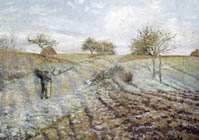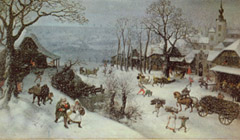
In his essay 'On the Surface of Painting' in Essays on Art & Language (October, 2003) Charles Harrison uses the example of Camille Pissaro's Hoarfrost - the Old Road to Ennery(1873) to highlight the split between Realist and Modernist painitng, stemming from Impressionism. He notes that 'from this landscape, this surface, the form of the peasant seems awkwardly extruded.' [p. 200] Pissaro was concerned for the plight of the rural poor, but Impressionism's all-over surface and atmospherics would either imply the merging of the figure into the landscape, or here causing the peasant to stand out like a sore thumb - which can be read as an unintended political message.
'It seems that the peasant could not be represented within a technically consistent Impressionist landscape without losing just that monolithic property which was both his normal pictorial identity and his conventional Realist attribute. The price of preserving that attribute is that the figure is, as it were, refused by the technically resolved Impressionist landscape. What the painting narrates is the divergence of two trajectories: on the one hand those discourses within which rural labour and the identity of the peasantry were possibly realistic topics; on the other hand the developing discourses of artistic modernism, with their emphasis on the autonomy of expression and of pictorial form. ... In attempting to include the peasant in the painted landscape without either anomaly or idealization, Pissaro was painting an unpaintable picture. ... It was the pragmatic Monet who solved Pissaro's problem. He simply omitted the peasant, and in omitting him as token removed a type of obstruction to the progress of the plausibly modern surface. In Monet's work after 1873 the contingently irreconcilable gives way to the aesthetically resolved. This shift involves a change in the kinds of places - the kinds of worlds - that are viewed as potentially picturesque. By the early years of the twentieth century pictorial atmosphere had come to be represented in the dominant critical discourse as signifying emotional or psychological or even spiritual climate.' [pp. 202-203]
For Harrison the figure 'fails to be either in the picture or on the ground,' [p. 201] appearing to be pasted on top in a manner akin to the dabs of white paint in Valckenborch's Winter Landscape. This inspires Harrison to question usual ideas about the trajectory of modernist painting, as a 'triumph of individulism and of independent expression.' Instead, 'the same history can also be recounted as a dislocation or transformation of the irresolvable pictorial demands of realsim into a language of displacement, evacuation and exhaustion.' Perhaps thinking especially about the work of Jackson Pollock or Robert Ryman, Harrison concludes that: 'From the concept of the all-over expressive painting it is then a small step into the ironies of the surface of snow.' [p. 203]


Earlier in the essay Harrison uses Lucas van Valckenborch’s Winter Landscape (1586) to introduce complex ideas around the tension between perceptions of surface and illusion of depth. This is whilst acknowledging that the painting is a mediocre example of the popular landscape genre of depicting the four seasons:
'Across the surface of the canvas and scarcely diminishing in scale from bottom to top, touches of white paint represent falling snow. It is not a small painting and these are not mere feathery indications, but palpable dabs from a loaded brush. To a taste fed on Modernist painting … it is by virtue of this surprising frankness that the painting achieves more than anecdotal charm. … What gives us pleasurable pause is that strange and distinctive form of scepticism about appearances which is set in play when the allure of imaginative depth meets resistance from the vividness of decorated surface.' [pp. 176-177]
'The act of perception is an act of consumption in which we hazard nothing. The world of our own antecedent associations is pandered to and privileged in ways which distract us from the uninteresting contingencies of the work’s production, and thus from the relative ordinariness of what it is actually of. ... By contrast, the kind of painting I have in mind is one which presents some aspect of its own production as a bar to unreflective consumption; which renders problematic the relationship between what it represents and how it represents it; which figuratively embodies time as a necessary aspect of its own coming-into-existence; which is therefore not possibly perceived as a mere glimpse or scene or effect, but which imposes on the spectator a necessity for engagement with what it is of – an engagement which is disciplined by acknowledgement of the painting’s own factitious character, and which is objective to the extent that the spectator’s own preferences and predispositions are regulated by the priority of that acknowledgement.' [p. 195]